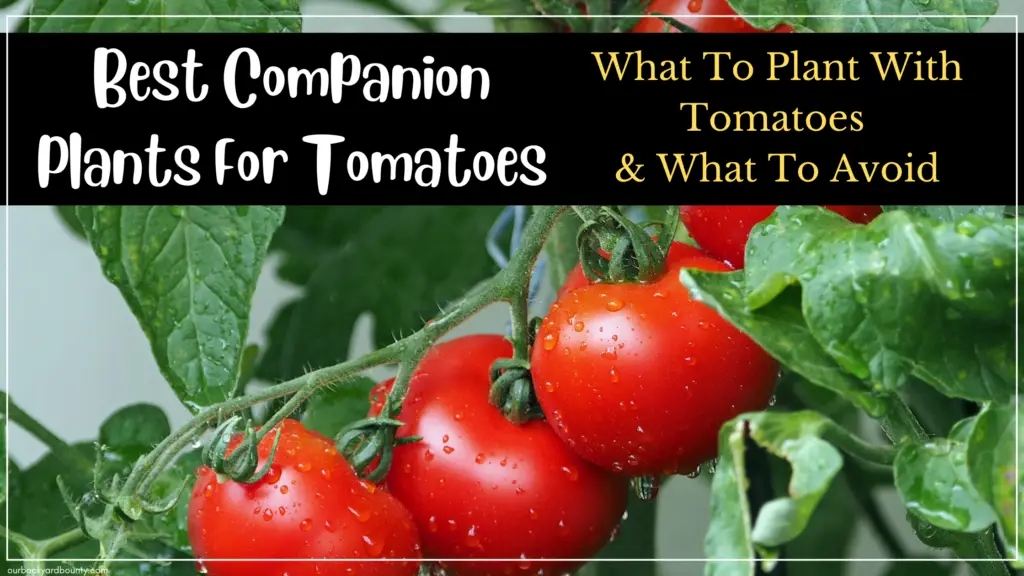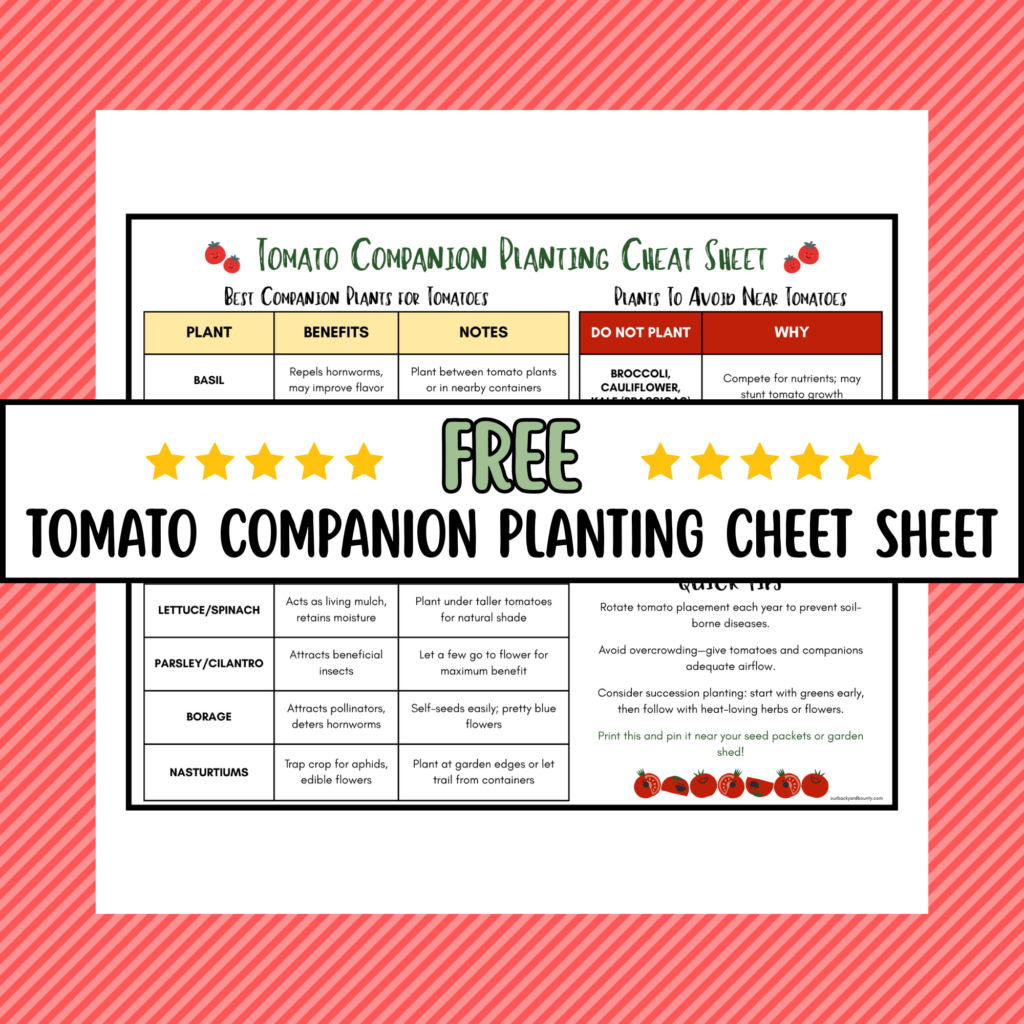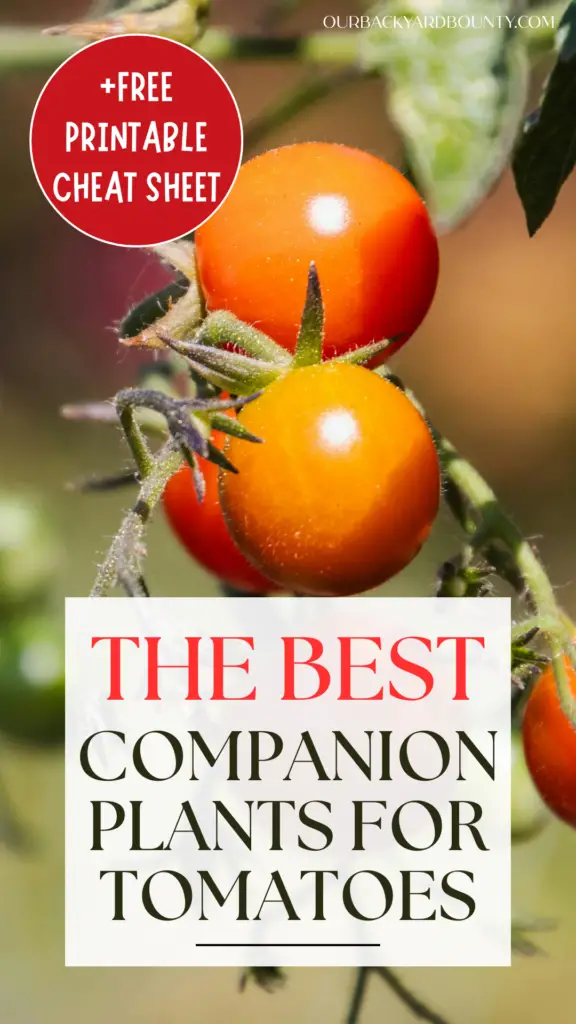This post is all about best companion plants for tomatoes.

Best Companion Plants For Tomatoes
If there’s one plant that totally earns its keep in the backyard garden, it’s the tomato. Juicy, versatile, and super easy to grow, even for chaos gardeners like me! Tomatoes really thrive when they have the right plant neighbors. That’s where companion planting comes in.
By growing certain herbs, flowers, and veggies alongside your tomatoes, you can boost their growth, repel pests naturally, and even improve their flavor. The best news is that it doesn’t have to be complicated. Whether you’re tucking basil between your tomato cages or lining your raised bed with marigolds, these small choices can make a big difference in your tomato yields.
As a means for providing for my family, I may earn commissions if you shop through the links on this page at no additional cost to you. Thank you!
In this post, I’ll walk you through the best companion plants for tomatoes, including what to avoid and a few easy layout tips to help you get started—no overly complicated planting charts required.
Why Companion Planting Works for Tomatoes
Companion planting isn’t just garden folklore, it’s a tried-and-true method that uses nature’s own systems to help plants thrive. When it comes to tomatoes, the right companions can make a noticeable difference in how well your plants grow, how many pests you deal with, and even how good your tomatoes taste.
So, why does companion planting matter for tomatoes? Let get into it.
Pest Control: Certain herbs and flowers like basil and marigolds release scents that actually repel common tomato pests like aphids, hornworms, and whiteflies. Other companion plants like nasturtiums, act as “trap crops” and they lure pests away from your tomatoes.
Improved Pollination: Plants like borage and marigolds attract bees and beneficial insects that help pollinate your tomato flowers. This helps improve your yields and get great harvests all season long.
Disease Prevention: Good companion planting will improve airflow and prevent disease. Some plants even release compounds into the soil that help prevent fungal issues.
Efficient Use of Space: Tomatoes grow tall, which makes them great partners for low-growing greens like lettuce or root crops like carrots that can fill in below and help suppress weeds.
Flavor & Growth Boost: This might sound hard to believe, but many gardeners swear that growing basil near tomatoes improves their flavor! Whether it’s science or just great synergy, it works for many backyard gardeners.
You don’t need a huge garden or fancy setup to take advantage of companion planting. Even a few pots on the patio can benefit from the smart use of companions.
Best Companion Plants for Tomatoes
These tried-and-true companion plants can help your tomatoes truly thrive! Whether you’re planting in raised beds, containers, or a scrappy backyard patch, the benefits will be bountiful. Some deter pests, others improve growth, and many do double-duty. Pick a few to try this season, and let your garden do the rest!
1. Basil
Basil is one of the most classic tomato companion plants. Not only does basil help repel tomato hornworms and aphids, but many gardeners believe it actually improves tomato flavor. Basil also grows well in containers tucked alongside tomatoes, making it perfect for small spaces. As an added benefit, basil can be used to amplify so many delicious recipes!
2. Marigolds
Marigolds are a natural pest deterrent, especially against nematodes and whiteflies. Their bright blooms attract pollinators and beneficial insects, too. Plant them around the borders of your tomato bed or in small clusters for the best effect. (If you’re a fellow chicken keeper, marigolds also make great treats for chickens! It’s beneficial to their health, and gets you those pretty deep orange yolks! (See: Herbs & Flowers To Plant Around Your Chicken Coop)
3. Onions
These pungent bulbs confuse and repel pests like spider mites and aphids due to their strong scent. Tuck a few around the perimeter of your tomato plants—you’ll hardly notice them until harvest time.
4. Garlic
Like onions, garlic repels pests due to their strong scent. Garlic in particular is known to suppress fungal diseases.
5. Carrots
Carrots make great tomato neighbors because they grow underground, helping to aerate the soil without competing too heavily for nutrients. You might end up with smaller carrots, but the tradeoff is happy tomato roots. Bonus: carrots love the shade tomato plants provide in during those really hot days.
6. Lettuce
These cool-season greens enjoy a little shade from taller plants. When planted near the base of tomatoes, lettuce acts as living mulch, keeping weeds down and soil moisture up which is especially useful in hot summer weather.
7. Spinach
Just like lettuce, spinach is one of the best companion plants for tomatoes and enjoys the shade that the tall tomato plants offer. Planting spinach (and lettuce) around the base of the tomatoes keeps weeds at bay, and improves soil moisture.
8. Parsley
Herbs like parsley attract beneficial insects such as hoverflies and ladybugs, which help keep pests in check. Let a few go to flower, and you’ll bring in even more garden helpers.
9. Cilantro
Cilantro also helps to attract beneficial insects and keep the unwanted pests away.
10. Borage
Often overlooked, borage is a powerhouse companion plant for tomatoes. It attracts bees and other pollinators and is said to improve tomato growth, and even helps deter tomato hornworms. Its fuzzy leaves and attractive star-shaped flowers add a touch of beauty to the garden as well.
Borage seeds are harder to find at your local stores. Grab this highly-rated seed packet from Amazon. It comes up 1200 seeds, and have great germination rates.
- EXTRA LARGE PACKET contains over 1 full ounce of pure live seeds (1,200+ seeds!) – Enough to cover 100 square feet.
- THE FRESHEST SEEDS available lead to high germination rates, making your gardening easy, successful, and fun!
- PREMIUM PACKAGING designed for optimal seed storage, with full planting instructions and reusable zipper – Great for gift giving!
- GUARANTEED TO GROW! – We want everyone to be a successful gardener, and we’re always here with personal gardening advice. If you have any issue with our seeds, we’ll refund or replace them no questions asked!
- QUICK GROWING AND EDIBLE wildflower makes a great addition to any garden. Beautiful blue blooms in as little as 7 weeks!
11. Nasturtiums
Nasturtiums are an edible flower that functions as a trap crop, drawing aphids and other pests away from your tomatoes. They sprawl easily, so plant them at the edge of your tomato beds or let them trail from nearby containers. Their leaves and flowers add a nice peppery taste to your salads! The flowers also add some visual appeal to your garden!
Nasturtium seeds are also harder to find at your local stores, but you can grab this highly-rated packet from Amazon.
- Variety: Jewel Mixed Nasturtium, scientifically known as Tropaeolum nanum, is a compact variety of nasturtium, ideal for small gardens, containers, or borders.
- Appearance: This variety features vibrant, jewel-like flowers in shades of red, orange, yellow, and sometimes mahogany. The flowers are slightly smaller than those of T. majus but are just as striking.
- Growth Habit: Tropaeolum nanum grows in a bushy, dwarf form, typically reaching only about 12-18 inches in height, making it excellent for ground cover or in pots where space is limited.
- Edibility and Uses: Both the flowers and leaves are edible, often used to add color and a peppery flavor to salads. They are also rich in vitamin C and can be used for their ornamental purpose in culinary dishes.
- Quality: All Nasturtium seeds packaged by Seed Needs are intended for the current and the following growing seasons. All seeds are stored in a temperature controlled facility that is free of significant amounts of moisture.

What You’ll Find Here
Are you eager to embrace the homesteading lifestyle, but worried about not having enough land? Fear not, for you don’t need vast acres to become a mini homesteader. With a little creativity and effort, you can transform your backyard into a thriving homestead, complete with chickens and a garden. Imagine the satisfaction of growing your own food and using it to whip up delicious, healthy meals. And if you’re ready to take the plunge and raise backyard chickens, you’ve come to the right place. This is where we’ll guide you through the world of modern homesteading.

Follow Us On Tik Tok and Instagram!



